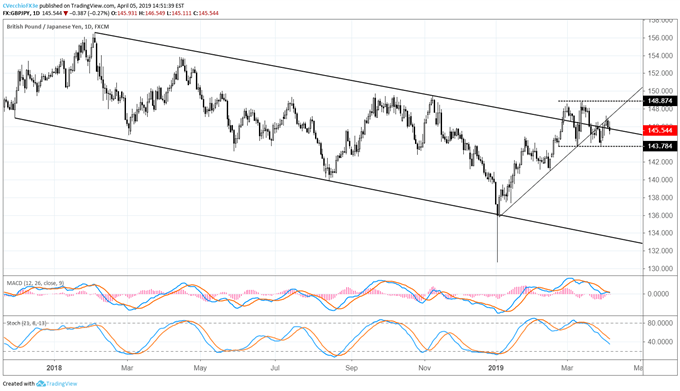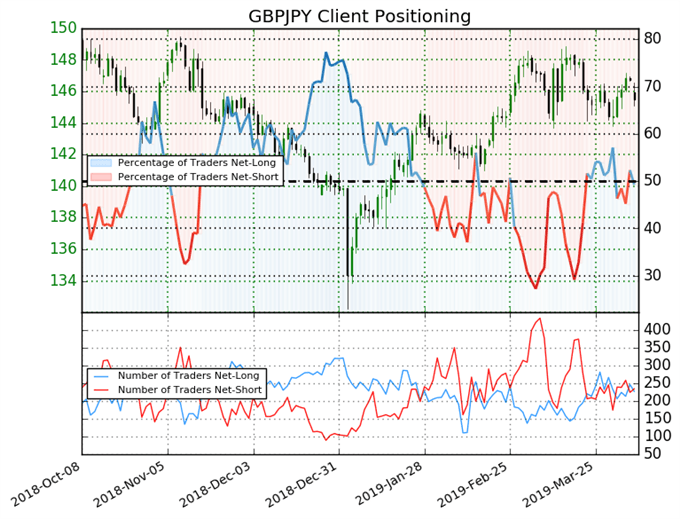Talking Points:
- The February UK Industrial Production Manufacturing Production, and GDP are due on Wednesday at 08:30 GMT.
- Consensus forecasts expected UK industrial and manufacturing production to have contracted in February, and for GDP to come in flat.
- Retail traders have started buying the Canadian Dollar, with USDCAD net-shorts having risen in recent days.
Join me on Mondays at 7:30 EDT/11:30 GMT for the FX Week Ahead webinar, where we discuss top event risk over the coming days and strategies for trading FX markets around the events listed below.
04/10 WEDNESDAY | 08:30 GMT | GBP Industrial & Manufacturing Production, GDP (FEB)
Tensions over Brexit have increased in recent weeks, and the fact that the UK government has blown past the original March 29 deadline has led to an increased level of uncertainty impacting business, consumer, and economic confidence.
With confidence turning lower in Q1’19 on the back of Brexit, there’s little surprise that real economic data is starting to show signs of duress. According to Bloomberg News, the trio of UK data releases on Wednesday morning should underscore the deteriorating economic environment.
February UK Industrial Production is due to have grown by only 0.1% over the past month, down from the 0.6% monthly rate seen in January; the year-over-year reading is due in at -0.8% from -0.9%. February UK Manufacturing Production will take a similar path: 0.2% from 0.8% (m/m); and -0.7% from -1.1% (y/y). Ultimately, the monthly February UK GDP reading is due in at 0% from 0.5%.
Pairs to Watch: EURGBP, GBPJPY, GBPUSD
GBPJPY Price Chart: Daily Timeframe (November 2017 to April 2019)

Volatility in the GBP-crosses remains elevated relative to other major currency crosses, even if 1-week and 1-month implied readings have fallen in recent days (back towards their lowest level since March 19).Nevertheless, there hasn’t been much progress made over the past several weeks. Since February 22, GBPJPY prices have traded in a range between 143.78 and 148.87.
Accordingly, to avoid the latest Brexit news from interfering with any decision making, traders may find that bulls will have an easier time more than 148.87 while bears may take control below 143.78. It should be noted that GBPJPY has failed to retake the uptrend from the post-Yen flash crash closing low.
IG Client Sentiment Index: GBPJPY (April 5, 2019)

Retail trader data shows 49.2% of traders are net-long with the ratio of traders short to long at 1.03 to 1. The number of traders net-long is 5.8% lower than yesterday and 6.9% lower from last week, while the number of traders net-short is 9.6% lower than yesterday and 12.4% higher from last week.
We typically take a contrarian view to crowd sentiment, and the fact traders are net-short suggests GBPJPY prices may continue to rise. Positioning is less net-short than yesterday but more net-short from last week. The combination of current sentiment and recent changes gives us a further mixed GBPJPY trading bias.
FX TRADING RESOURCES
Whether you are a new or experienced trader, DailyFX has multiple resources available to help you: an indicator for monitoring trader sentiment; quarterly trading forecasts; analytical and educational webinars held daily; trading guides to help you improve trading performance, and even one for those who are new to FX trading.
--- Written by Christopher Vecchio, CFA, Senior Currency Strategist
To contact Christopher, email him at cvecchio@dailyfx.com
Follow him in the DailyFX Real Time News feed and Twitter at @CVecchioFX






